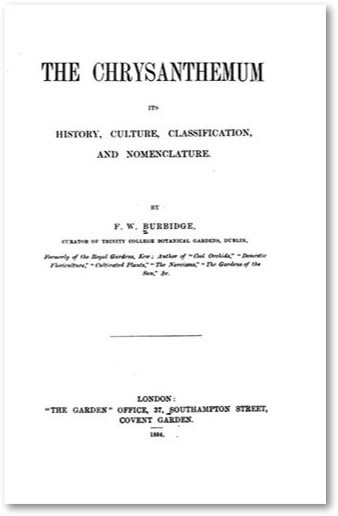
Musings » The Chrysanthemum


London
"The Garden" office 1884
This is a very small book, of the sort which is often called “a slim volume”. The idea of devoting a whole book to one flower was getting underway by the end of the nineteenth century. Roses, orchids and camellias had books of their own much earlier because of their vast complexity and opportunity for exquisite images. Flowers like the chrysanthemum were relegated to larger compilations and general floral histories. The first book about sweet peas appeared in 1892.
Frederick William Burbidge, 1847 – 1905, was one of those stalwart Victorian lads who improved themselves diligently. He was born in Leicestershire, the son of a fruit farmer. By the time he was apprenticed to a gardener he had already absorbed a good deal of knowledge about plants and the land. Burbidge was also a very gifted draftsman and watercolorist. The combination of these talents led to his successful career. With only a rather sketchy formal education he eventually rose to become the director of the botanical garden at Glasnevin in Dublin.
He was clearly an expert and opens the preface of this book with comments about rapid changes in the chrysanthemum world. He issued his 2nd edition just after the National Chrysanthemum Society was formed in London.
The introductory pages give a quick view of the history of the plant in China and Japan and its arrival in Western Europe about 200 years before his time. The elusive Captain James Cunningham may have been the first to send the flower back in 1602. Once it caught on in the 18th century it stimulated the design of lushly printed fabrics known as chintz. Huge blowsy chrysanthemum blossoms adorned curtains, dresses and upholstery for many years.
Burbidge went to some pains to lay out the differences between varieties based on the shape and disposition of the petals making up the flowerhead. As a practical hands on gardener Burbidge tells you how to propagate and cultivate the flower. There are other practical matters and advice for those wishing to create award winning flowers. It was a good formula and one which would be employed in similar books for many years to come.
The most interesting part of it for me is the long list of cultivars at the end. Fully 50 pages out of the 140 are devoted to this list. Here Burbidge shows what a master he was. He had patiently accumulated specific information about every chrysanthemum which had been released publicly. Each entry lists the type, frequently the breeder, and enough description to recognize it easily.
It is startling to realize that more than 100 years ago there were already dozens of cultivars straining the nomenclature and making the nurseryman’s life difficult. Which ones should he stock? ‘Oscar Wilde’, bright red with long fringe-like florets? I expect the breeder regretted that choice of name. How about the dark chestnut ‘Oliver Cromwell’, named for the dour Puritan to whom flowers were trumpery nonsense?
The torrent of gorgeous books about plants and gardens which washes over us in great streams is descended from seemingly very inauspicious ancestors. Confronted with Burbidge’s The Chrysanthemum at a time when even a 10 year old child can adorn his homework with complex colored images downloaded from the Internet, the austere use of steel engravings in a black sea of text is very bracing and yet the book teaches us a great deal in a small space and with a minimum of effort.

